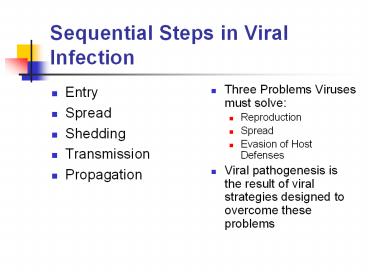Sequential Steps in Viral Infection Entry Spread Shedding PowerPoint PPT Presentation
1 / 19
Title: Sequential Steps in Viral Infection Entry Spread Shedding
1
Sequential Steps in Viral Infection
- Entry
- Spread
- Shedding
- Transmission
- Propagation
- Three Problems Viruses must solve
- Reproduction
- Spread
- Evasion of Host Defenses
- Viral pathogenesis is the result of viral
strategies designed to overcome these problems
2
Entry
- Skin/Mucous Membranes
- Transcutaneous Injection
- Urogenital Tract
- Oropharynx and GI Tract
- Respiratory Tract
3
(No Transcript)
4
Entry
- Skin/Mucous membranes
- Invasion of intact skin unlikely
- Stratum corneum is keratinized, no live cells
- Break in skin allows viral access to
- specific underlying cells
- Herpes Simplex Virus and pox viruses can
replicate in germinal cells in epidermis and
fibroblasts and macrophages in the dermis - Papillomaviruses (causes cervical warts and
cancer) infect germinal cells of the epidermis
but complete life cycle only in the more
superficial stratum granulosum
5
Entry
- Skin/Mucous membranes
- Conjunctiva of the eye a specialized mucous
membrane - Certain adenovirus serotypes
- Coxsackie virus A24
- Enterovirus 70
- Herpes Simplex Virus
- Herpes Zoster
- Virus infection can cause severe conjuncvititis
Picornaviruses (Acute Hemorrhagic Conjunctivitis)
6
Entry
- Transcutaneous Injection
- Arboviruses (Insect borne)
- Virus life cycle must alternate between insect
vector and vertebrate host (e.g. West Nile Virus,
Dengue Virus) - Virus is injected when the insect takes a blood
meal - Symptomalogy can differ widely non-symptomatic
to fatal encephalitis for West Nile, and slight
febrile illness to fatal hemorrhagic fever for
dengue - Bite of infected animal (Rabies)
- Intramuscular innoculation with
virus-contaminated saliva - Virus has pre-dilection for the limbic system
produces personality changes - IV innoculation
- HIV
- Hepatitis C
7
Entry
Puncture wound from needle used to culture
genital herpes
- Urogenital Tract (Sexually Transmitted)
- Infects/replicates in epithelial cells
- Herpes Simplex Virus-2 (herpes)
- Papillomaviruses (warts, cervical cancer)
- Transmucosal infection
- Hepatitis B
- Access circulation via surface capillaries that
supply mucous membranes - HIV
- textbook is not entirely correct HIV is probably
ferried to lymphoid organs to infect CD4
T-cells by dendritic cells that reside in the
submucosa
Condyloma acuminatum (HPV-6)
8
DC-SIGN A Conduit for Transfer of HIV to
Lymphoid Organs?
Geijtenbeek, T.B.H. et al, Cell 100 594
9
Entry
- Oropharynx and Gastointestinal Tract
ReoVirus
10
Entry
- Respiratory Tract
Hanta Virus (Sin Nombre Virus)
11
Spread
- Local Spread
- Dissemination
HIV in semen --Cell free virus vs
cell-associated virus --consequences for
prophylactic treatment
12
Poliovirus Viremia
Viremia decreases with onset of antibody response
13
Virus Spread from Blood to Tissues
Some Paramyxovirus (causes vasculitis)
(e.g. Mumps)
(Trojan Horse e.g. HIV)
14
Shedding
- GI Tract
- Feces
- Epithelial Cells (Reovirus)
- Liver---gtBile----gtBile duct (Hepatitis A)
- Poliovirus
- Respiratory Tract (Rhinovirus, Influenza)
- Aerosols, pharyngeal secretions
- Skin
- Papillomavirus (Warts)
- Pox viruses (smallpox)
- Mucous Membranes (Oral/Genital fluids)
- HSV-1 (oral), HSV-2 (genital)
- Epstein Barr Virus (mononucleosis--kissing
disease in college kids) - Rabies (saliva)
- HBV, HIV (semen)
- Blood, Urine, Milk
- HBV, HIV, HCV, CMV (persistent viremia)
15
Enviromental Survival of Shed Virus
- Transmission depends
- Amount of shedding
- Duration of Shedding
- Survival time in environment
- HIV not infectious after drying
- Poliovirus sensitive to low humidity
- Decrease transmission during Winter
- Transmission all year in tropical climates
- GI Environment (acid inactivates most viruses)
- Hep A, B, C, D, E all replicate in liver and are
secreted in bile but only Hep. A and E are
transmitted by fecal-oral route
16
1918 flu pandemic killed 40 million people in 5
months ( same killed by HIV in the last 20
years)
17
Transmission/Propagation
- Acute Infections
- Requires minimal population threshold
- Transmissibility, Rogt1
- E.g. Measles will eventually disappear if
isolated population lt500,000 - Ab prevalence may provide an indicator of
transmissibility age and population-specific
incidence
Cases per 100 population
with Antibody
18
Transmission/Propagation
- Persistent Infections
- Can persist in small populations
- HIV, HBV, VZV
19
Control and Eradication
- Effective vaccines can eradicate viral infections
that result in acute infections in relatively
short periods of time - Smallpox, Polio(?)
- Persistent infections will take generations to
disappear, even with effective vaccines

